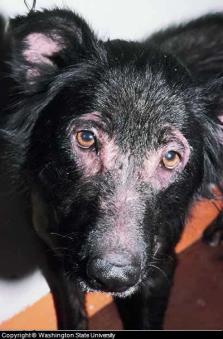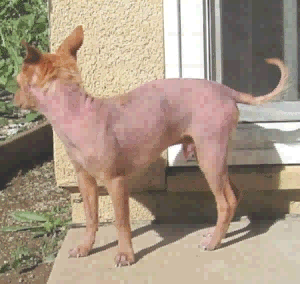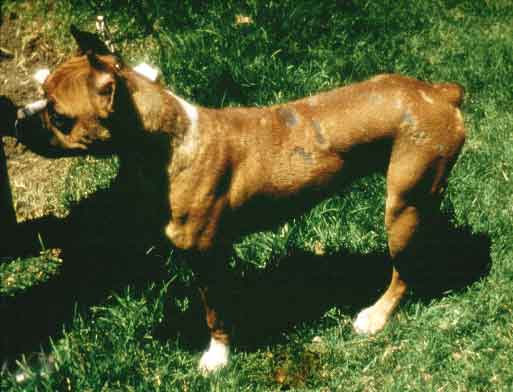"A dog with itchy skin can be caused by diet, parasites, fungus or commonly allergy. Diagnosis is accomplished through the examination of skin scrapings and location of the dog skin problem. Treatment involves identifying and removing the cause of the condition."
A dog with itchy skin is can be due to problems that range from the simple such as a skin allergy to something more serious. It’s important not to ignore itchy dog skin, though, because excessively itchiness can be a symptom of a more serious problem.
Symptoms
Beyond the obvious, signs of itchy skin include:
- Excessive licking of their skin or paws
- Red and inflamed skin from excessive itching
- Thickened skin
- Unhealthy looking coat which is related to unhealthy skin such as dryness or dull color
- Alopecia (hair loss)
- Papules or red skin bumps
Diagnosis Canine Itchy Skin
Diagnosing skin can be a challenge, because there are so many possible causes. The most likely cause of a dog with itchy skin is an allergic reaction to either food or something in the dogs environment. For example, the sudden onset of allergy may coincide with the introduction of a new dog treat or a change in season.
The location of the canine itchy skin can indicate the cause of the problem:
- Rear of Body, Tail and Legs: Cause is likely Fleas
- Front of body, dog rubs face, licks foot, scratches arm pit and neck, scratches chest: Cause is likely hay fever
- Entire body itches: Dog food allergy or seborrhea (skin flaking like dandruff)

- Entire body with skin that flakes, skin appears to move: Cause of dog with itchy skin is probably mange mites (scabies or dog mange)

Diagnosis of common culprits for itchy skin are performed using some of these techniques::
- Fleas: You can tell if a dog has fleas by looking at the area near the tail and anus. Using a flea comb see if you pull off small black and white specs.. They may even look like small pieces of dirt or a mix of salt (eggs) and pepper (flea feces). To be sure, crush the specs against a wet paper towel. If it turns red, your dog has fleas.
- Skin Parasites: Parasites refer to any organism that lives off your dog including fleas, lice, mange or scabies causing mites, ear mites and ticks.: There are skin tests to determine exposure to disease such as Lyme disease from ticks. For mange, a veterinarian will take a skin scraping and look for the presence of mites. Ear mites, as the name implies will cause scaling, redness and itching on the ears only.
- Fungal Infections such as Ringworm (dermatophytosis) which has red spots with pale centers
- Yeast Infections ((Malassezia) - this refers to dog skin fungal infections. Skin becomes red, and scaly and skin takes on a thickened appearance.

- Dry Skin - unhealthy, dry and dull looking skin
Treatment of Dog with Itchy Skin
The first concern is to bring some temporary relief to a dog that is itching. Some tips include:
- Cold Bath: a brief cool bath can bring some relief for a dog with itchy skin. Try and keep your dog in the bath for at least 10 minutes.
- Oatmeal Bath: The use of an oatmeal bath such as Earthbath, contains aloe and oatmeal to re-moisturize a dog's skin. can help with itch. You can also use water and Aveeno colloidal oatmeal bath. You can use regular home oatmeal by filling a sock with oatmeal, then running the water from the spout through the sock/oatmeal into the tub.
- Moisturizers: Human skin moisturizers that are diluted such as Avon Skin So Soft or Keri can be of help. Use 1 tablespoon per gallon of water and spray lightly onto dog after bath.
Fleas - If the itching is due to fleas, a flea treatment is necessary. Most veterinarians recommend that treatment begin with the elimination of fleas from the dogs body. This involves the use of a herbal flea dip such as the one offered by Adams, combined with the use of a herbal shampoo. Dips have the advantage of having a lasting or residual effect while shampoos do not.
This is followed by a preventative and product that kills fleas such as a topical spot-on treatment such as Advantage. Many spot on treatments such as Frontline Plus and Revolution are effective for other skin parasites as well.
All of these treatments begin to work almost immediately to kill fleas, but it may take a few days for your pet to stop itching as the spot on are IGR, which interfere with the fleas life cycle. It prevents fleas from becoming adults, but the existing adults need to slowly die off.
Fungal Infection: If the itching is caused by a fungal infection, medication and baths with medicated shampoos or the the use of a lime-sulfur dip such as Dermisil combined with a herbal shampoo is the treatment of choice. The baths will help stop the itching as well as treat the fungus.
Diet: Improving the diet will naturally help. Most commercial dog foods supply adequate nutrition, but if you’re not sure, ask your vet what he or she recommends feeding your dog. Often fatty acid supplements for skin can be of help as part of a dogs diet such as Dermaquin. These types of supplements can take up to 2 months to start working.
Also the use of a natural remedy such as Skin and Coat Tonic can help to improve skin and coat condition by strengthening the body's natural abilty to grow health hair and fight off skin problems.
Dog Paw Itch: If a dog is licking its paws, Epsom salts could bring some relief. Fill a bath or pan with a few inches of water. Use 2 cups of salts and soak the dogs paws for 5 to 10 minutes.
References Dog with Itchy Skin:
Scott, D. W., Miller, W. H., Griffin, C. E.
Muller and Kirk’s Small Animal Dermatology
Mueller, R. S.
Flea Control in Veterinary Dermatology
Have A Question about Your Dog's Skin Condition? Our Team Will Answer It for Free!
Do you have a question or comment? Share it!
Our editors will pick 1 question to answer each week. Please include your dog's age, breed, medical history, medications and if possible, a picture of the condition.
We will do our best to get back to you quickly (it depends on how many questions we receive each day). If you do require an immediate response we suggest using this online dog veterinary service that is available now.
